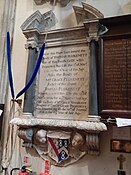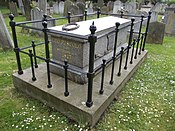
Chiswick is a district in the London Borough of Hounslow, West London, England. It contains Hogarth's House, the former residence of the 18th-century English artist William Hogarth; Chiswick House, a neo-Palladian villa regarded as one of the finest in England; and Fuller's Brewery, London's largest and oldest brewery. In a meander of the River Thames used for competitive and recreational rowing, with several rowing clubs on the river bank, the finishing post for the Boat Race is just downstream of Chiswick Bridge.
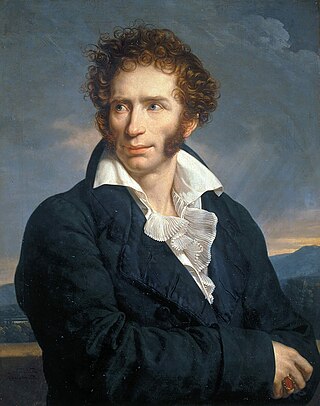
Ugo Foscolo, born Niccolò Foscolo, was an Italian writer, revolutionary and poet.
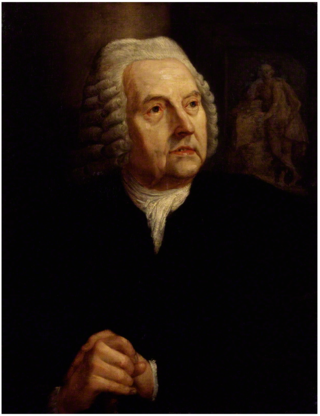
Peter Scheemakers or Pieter Scheemaeckers II or the Younger was a Flemish sculptor who worked for most of his life in London. His public and church sculptures in a classicist style had an important influence on the development of modern sculpture in England.

Louis-François Roubiliac was a French sculptor who worked in England. One of the four most prominent sculptors in London working in the rococo style, he was described by Margaret Whinney as "probably the most accomplished sculptor ever to work in England".
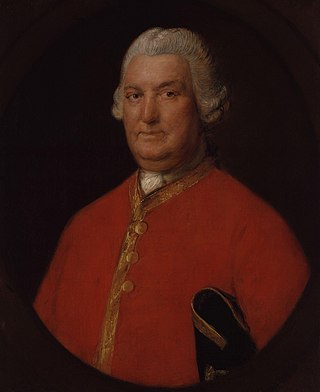
Major-General Stringer Lawrence was an English soldier, the first Commander-in-Chief of Fort William.
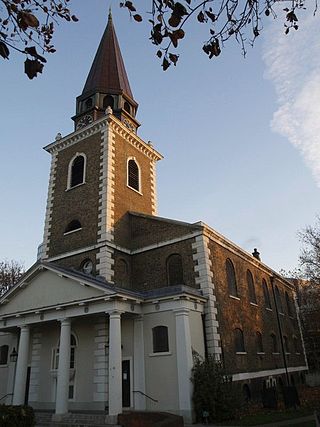
St Mary's Church, Battersea, is the oldest of the churches in Battersea in the London Borough of Wandsworth, in the inner south-west of the UK's capital city. Its parish shared by three Anglican churches is in the diocese of Southwark. Christians have worshipped at the site continuously since around 800 AD. It is a Grade I listed building for its combined heritage and architectural merit.
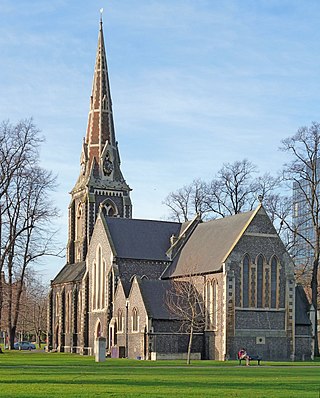
Turnham Green is a public park on Chiswick High Road, Chiswick, London, and the neighbourhood and conservation area around it; historically, it was one of the four medieval villages in the Chiswick area, the others being Old Chiswick, Little Sutton, and Strand-on-the-Green. Christ Church, a neo-Gothic building designed by George Gilbert Scott and built in 1843, stands on the eastern half of the green. A war memorial stands on the eastern corner. On the south side is the old Chiswick Town Hall.

The Parish Church of St Cuthbert is a parish church of the Church of Scotland in central Edinburgh. Probably founded in the 7th century, the church once covered an extensive parish around the burgh of Edinburgh. The church's current building was designed by Hippolyte Blanc and completed in 1894.

The Church of St Wilfrid is an Anglican church in the suburb of Northenden in Manchester, England. It stands on Ford Lane, close to the River Mersey, approximately 8 kilometres (5.0 mi) south of Manchester city centre.

Old All Saints Church, or Harcourt Chapel, is a redundant Church of England church near the village of Nuneham Courtenay, Oxfordshire, England. It is recorded in the National Heritage List for England as a designated Grade II* listed building, and is under the care of the Churches Conservation Trust. The church is southwest of the village, in the grounds of Nuneham House overlooking the River Thames, some 6 miles (10 km) southeast of Oxford.

The Church of Atalaia is a church in the civil parish of Atalaia, municipality of Vila Nova da Barquinha, in the Centro region of Portugal. The Renaissance-era religious building, has been molded by successive layers of Mannerist and Baroque decorative and structural elements, that include the portico, but whose origin dates to the Gothic architecture of the early 16th century. The unique central tower, Baroque azulejo tile-work and 16th century pulpit are important characteristics of this parish church.
Alexander Handyside Ritchie was a Scottish sculptor born in Musselburgh in 1804, the son of James Ritchie, a local brickmaker and ornamental plasterer, and his wife Euphemia. The father in turn was the son of a fisherman and amateur sculptor.
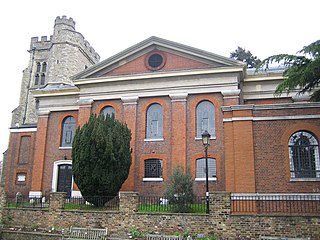
St Mary's Church, Twickenham, also known as St Mary the Virgin, Twickenham, is a Grade II* listed Church of England place of worship dedicated to Saint Mary the Virgin. It is on Church Street, Twickenham in the London Borough of Richmond upon Thames, England.

St Martin's Church is a Grade I listed Anglican church, dedicated to Martin of Tours, in Ancaster, Lincolnshire, England. The church is 6 miles (10 km) north-east from Grantham, below the southern edge of the Lincoln Cliff, and at the side of High Dyke, part of the old Ermine Street Roman road. St Martin's is in the ecclesiastical parish of Ancaster and Wilsford, in the Deanery of Loveden, and the Diocese of Lincoln.

Monuments in the Basilica of Santa Maria del Popolo are tombs and funerary monuments ranging from the 15th to the 19th centuries. Since its rebuilding in the 1470s by Pope Sixtus IV the Basilica of Santa Maria del Popolo was one of the favourite burial places for members of the papal aristocracy, clergy and literati. Foreign artists were also buried in the church due to its location near their favourite quarter in Rione Campo Marzio. The high number of tombs and monuments makes the basilica a whole museum of sculpture as Jacob Burckhardt phrased it in his famous guide of Italian art in 1855. Besides the tombs in the side chapels and the choir there are many other funeral monuments in the aisles and the transept. During the centuries several monuments were demolished and others were relocated to give place to newer ones.
Thomas Scheemakers, or Thomas Scheemaeckers according to his own signature, was a sculptor in late 18th-century London. He was the last of the Scheemaeckers family of sculptors originally from Antwerp. Several of his works are held by the Victoria and Albert Museum and can be found in parish churches around England.

St Mary and St Benedict is the Church of England parish church for the village of Buckland Brewer near Bideford in North Devon. It is part of the benefice of the Hartland Coast Team Ministry. This falls within Hartland Deanery, in the Archdeaconry of Barnstaple in the Diocese of Exeter. Begun in the 14th-century with 15th-century additions and retaining several architectural features from the first church of about 1100, the building was much restored in the 19th-century and has been a Grade II* listed building on the Register of Historic England since 1958.

Old Chiswick is the area of the original village beside the river Thames for which the modern district of Chiswick is named. The village grew up around St Nicholas Church, founded c. 1181 and named for the patron saint of fishermen. The placename was first recorded c. 1000 as Ceswican. In the Middle Ages the villagers lived by fishing, boatbuilding, and handling river traffic. The surrounding area was rural until the late 19th century.

Chiswick High Road is the principal shopping and dining street of Chiswick, a district in the west of London. It was part of the main Roman road running west out of London, and remained the main road until the 1950s when the A4 was built across Chiswick. By the 19th century the road through the village of Turnham Green had grand houses beside it. The road developed into a shopping centre when Chiswick became built up with new streets and housing to the north of Old Chiswick, late in the 19th century. There are several listed buildings including public houses, churches, and a former power station, built to supply electricity to the tram network.








